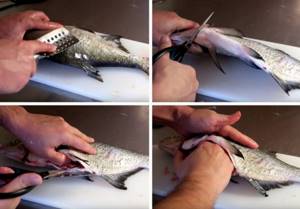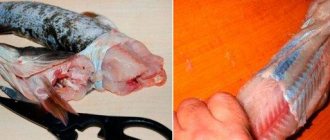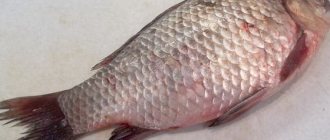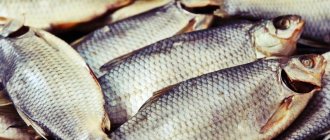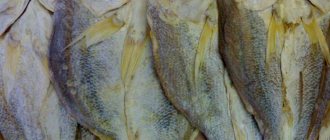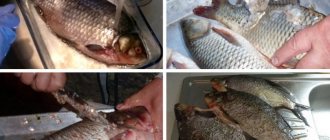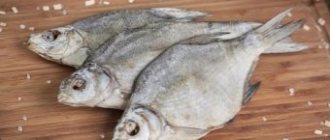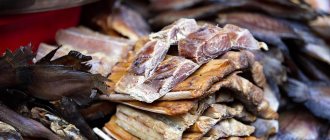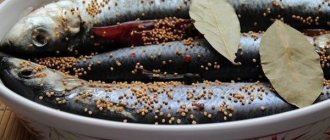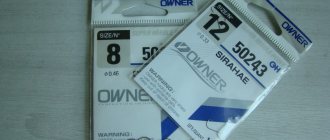Available and inexpensive, bream is one of those fish that can decorate an everyday and formal table; the main thing is to know how to cook it correctly and tasty, so that you don’t feel the bones. Despite the abundance of small bones and the characteristic smell of the inhabitants of fresh water bodies, you can create a real culinary masterpiece from simple fish.
Delicious fish is cooked in a frying pan or baked in the oven. avid fishermen love to cook a simple, but unusually aromatic fish soup over a fire, or bake bream on a grill. Dishes are prepared from simple ingredients and seasonings; they can be found in the arsenal of any housewife.
How to properly cook bream at home
To avoid pitfalls in the form of bones and smell, you can use simple techniques to prepare bream dishes without unnecessary hassle.
- To get rid of the unpleasant smell of fish, sprinkle the carcass with lemon juice, or even better, soak it in the juice for an hour (use a whole lemon per liter of water).
- When frying bream, do not make the pieces too thick, this will allow them to cook evenly. The ideal thickness of steaks is 3 centimeters, otherwise the top of the fish will be fried, but the inside will remain raw.
- Place the steaks only in hot oil, then the fish will not stick to the pan and will easily turn over to the other side. I know another simple trick: salt the oil in a frying pan over the entire surface, and then lay out the steaks. True, this salt must be taken into account when you begin to salt the fish itself.
- Fish meat will become much more tender if you marinate it in lemon juice. To improve the taste of bream, various herbs and seasonings are placed in its belly, then the meat will have time to soak from the inside during baking.
- To avoid suffering from small bones, cook the bream whole, or choose large carcasses, which have few bones.
How to deliciously cook bream in the oven
There are a huge number of recipes for cooking fish in the oven. I chose the most popular one for you, in sour cream with the usual set of seasonings. Bream is baked in steaks, so I advise you to take large specimens, weighing at least a kilogram. Then there will be fewer bones.
You will need:
- Bream – 2-3 carcasses.
- Onion – 2 heads.
- Garlic – 8 cloves.
- Sour cream – 1/3 cup.
- Mayonnaise – 1/3 cup.
- Flour – 4 large spoons.
- Sunflower oil - the same amount.
- Salt, pepper mixture.
How to bake:
- Wash the fish carcass, gut it, remove scales, cut off the tail, fins and head. Rinse the fish thoroughly, inside and out.
- Cut the bream into small steaks.
- Heat oil in a frying pan. Mix salt and pepper on a plate. Place flour on another plate.
- Roll the pieces first in spices, then in flour. Place in a frying pan and fry until lightly browned.
- At the same time, make garlic sauce by combining sour cream with mayonnaise and crushed garlic in a bowl. Add a little salt and stir well.
- Then take care of the onion - cut it into large half rings and also fry a little (you can do it in oil after frying the bream).
- Place the prepared steaks in an oiled pan and scatter onion half rings on top. Pour garlic sauce over everything and place in the oven.
- Bake the dish at 180 o C. Cooking time is 40-45 minutes.

How to cook whole bream in the oven
I’ve already introduced you to various options for baking whole bream – come in if you’re interested. Here I offer the most common and simple recipe. To avoid feeling the bones, take a large bream. Whether you bake the fish with its scales or peel it is up to you to decide. The scales, after proper baking, are easily separated and do not interfere.
We take:
- Large carcass.
- Sunflower oil.
- Lemon – ½ part.
- Salt, basil sprigs, pepper, fish seasonings.
How to bake:
- Gut the fish carcass. It is permissible to leave the head and tail, but be sure to remove the fins and gills from the head. Rinse the fish outside and inside.
- Rub the bream with lemon juice all over the carcass and inside. Leave to marinate a little.
- After 10-15 minutes, make longitudinal cuts with a knife over the entire surface. Insert basil sprigs and lemon slices if you have any left.
- Salt the carcass and coat generously with sunflower oil to prevent it from sticking to the foil.
- Place a sheet of foil on a baking sheet, leaving extra for wrapping the fish. Place the prepared bream.
- Cover with a tail of foil so that there are no holes left.
- Cook at 180 o C for about an hour. Baking time depends on the size of the fish.
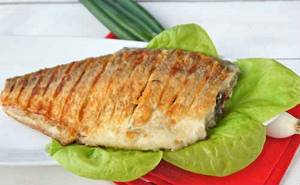
How to properly cut fish - an alternative cutting method
Whole fish, especially large ones, are a bargain. Firstly, this is the only way you can be completely sure of its freshness. Secondly, whole fish is cheaper than already cut fillets.
And thirdly, you get a bonus after cutting the fish - waste, from which you will then cook the broth. It can be used for soup or to make sauce. So you have a fish. With a head, scales, and entrails.
What to do? Cut it up quickly.
Clean and gut
- The very first thing to do when cutting a fish is to remove its scales.
To do this, it is convenient to use a special knife for cutting fish. But if you don’t have one, it’s okay - just take a knife with a short, strong blade. Start cleaning from the tail of the fish to the head. If the scales are attached to the fish too tightly, scald the carcass very quickly with boiling water. Once the scales are removed, rinse the fish with water. - Now you need to remove the entrails from the belly of the fish - gut it. Make a long cut on the abdomen from the caudal fin to the head with a knife or scissors.
The main thing when cutting fish is to carefully remove all the insides without damaging the gall bladder, which is located at the head next to the liver. If this does happen and very bitter bile spills onto the fish, remove all bile-stained parts of the fish, cut out and discard.You don’t want your dish to be distinctly bitter, do you? You need to remove the insides by pulling them out with your hand, grabbing them with a paper towel and helping yourself with a knife. Those insides that are attached to the head must be trimmed or pulled out with a strong movement.
- The internal cavity of the abdomen is covered with a film; it must be cut along the spine and removed.
If there is any blood left on the fish's spine, remove it with a knife or your hands under a strong stream of water. - If you need a whole fish for baking or a separate head for cooking soup, it’s time to start working on the gills; this must be done: the gills are bitter.
It is convenient to remove them with kitchen scissors. Lift the gill covers and trim the gills at the top and bottom where they attach to the head, then pull them out. If you work without gloves, then handle the gills with a paper towel or rag: they are prickly. - Use scissors to cut off the remaining fins on the tail, belly and head.
- Cut off the head of the fish perpendicular to the line of the abdomen, along the line of the gills. To cut off the head of a large fish, you will need a powerful knife.
- If before you only rinsed the fish, now you need to wash it very well.
Do this in cold running water, thoroughly washing all surfaces to remove any remaining scales and entrails. At the same time, conduct a meticulous analysis for missed flaws. Then thoroughly wash the board to remove any remaining scales and entrails. - If the fish is small, weighing 400-500 g, the resulting preparation will make an excellent portioned dish. If you plan to please your company with steaks, cut the fish into transverse pieces 2-3 cm thick.
Filling fish
- The next stage of cutting fish is removing the fillet.
- Place the carcass on the board. Run a knife along the spine, separating the fillet from the bones. Then remove the loin from the ribs.
- Do the same on the other side.
- Make a small cut near the tail to grab the skin.
- Hold the skin with one hand and slide the other along the fillet parallel to the table until you have a clean fillet in front of you.
- Remove the small bones in the body of the fish. It is better to do this with tweezers.
- Rinse the fish.
Alternative way to cut fish
1. There is another way of gutting - cutting the fish from the back. This looks completely unconventional, but it is necessary when you are going to stuff the fish and bake it “standing up” so that the filling does not fall out and as much of the juices and the fish’s own fat as possible remain inside. First, you still need to clean the carcass from scales and remove the gills.
Then, without cutting off the head, cut the back along the fin from the head to the tail, first on one side of the ridge, then on the other. Cut the ridge with scissors at the extreme points on the left and right of the head and tail and remove. 2. You can do this with scissors or gloved fingers, with a rag or paper towel.
The fish will be open in the middle, with the head and tail in the right places, but without a spine. Remove all entrails.
3. Using tweezers, remove any visible remaining seeds. Wash the fish thoroughly outside and inside and dry. Now you can stuff it.
Chef tips
- If you know for sure that you will be cutting fillets from large fish, and only fillets, then the scale removal step can be ignored. After all, you will be getting rid of skin anyway, so why complicate your life? Just gut the fish in the described way, divide it into layers and remove the skin; the scales are not a hindrance at all, and they will only add richness to the broth.
- If during cleaning the fish splashes everything around with its sticky scales, place it in a sufficiently deep and wide container (basin, trough) or in the sink. Fill with cold water so that the carcass is submerged ten centimeters. And remove the scales directly under water, holding the fish with a small cloth.
- When cutting up perch, pike perch, ruffe, sea bass or other owners of a sharp dorsal fin, we advise you to first remove it, otherwise it will be difficult for you to avoid being pricked by sharp needles.
To do this, carefully and not too deeply (about 1 cm), cut the back on one side of the fin with a knife or scissors, then on the other, firmly grasp the fin with a towel and pull it out away from the tail. Now you are in no danger. - 1 kg fish carcasses (heads, spines, tails, skin)
- 150 ml dry white wine
- 1 large onion
- 2 medium carrots
- 1 parsley root or small piece of celery root
- 1 bay leaf
- 1 bunch of greens (you can use stems of parsley, dill, cilantro)
- 5 peas each of black and allspice
- salt
Where to dispose of fish waste
After cutting the fish, trimmings remain: head, spine, fins, tail, skin. Many people don't realize that these unsightly leftovers make a wonderful broth that can be used to make soup, aspic, or sauce. To make a good broth, you only need a little, the actual fish trimmings and some vegetables and herbs for flavoring.
Fish broth
- Place the leftover fish in a saucepan, add 2 liters of cold water and place over medium heat. Bring to a boil, reduce heat to low and skim off foam. Cut the onion, parsley root and carrots into 4-6 pieces and brown in a dry frying pan, this will give the broth additional taste and a pleasant color.
- Add vegetables, herbs, allspice and black peppercorns to the broth, pour in the wine and cook for 40 minutes, covering the pan with a lid. Remember, the broth should not boil too much, otherwise it will become cloudy.
- In 10 min. Before the end of cooking, add bay leaf and salt. Strain the finished broth.
- If you don't need the broth in the near future, cool it completely, then pour it into individual serving molds and freeze.
Source: https://gotovlyvkusno.ru/razdelka-ryby/
Bream in the oven with potatoes
Another delicious variation on the theme of bream in the oven - with potatoes. A win-win in terms of taste and time savings.
Required:
- Large fish.
- Potatoes – 3 tubers.
- Sour cream – 30 ml.
- Flour - a couple of spoons.
- Lemon.
- Salt.
Cooking:
- Prepare the carcass for cooking: clean the scales, remove the entrails, cut off the head, fins, and tail. Rinse thoroughly everywhere. Cut into pieces, breaded with flour mixed with salt.
- Peel and cut the potato tubers into large cubes.
- Place the fish on a greased baking sheet and place the potatoes around and on top. Sprinkle everything with lemon.
- Bake for 25 minutes, preheating the oven to 180 o C. When the timer signals, remove the dish and generously pour sour cream on it.
- Return the pan to the oven for another 15 minutes.
How to cook bream in a frying pan with vegetables
The dream of every busy housewife is to prepare dinner quickly and tasty. Fish cooked simultaneously with a side dish is one of the embodiments of this miracle. The list of vegetables is allowed to vary by adding or removing.
Take:
- Big bream.
- Large carrot.
- Eggplant.
- Green peas - a handful.
- Bulb.
- Garlic cloves – a couple.
- Lemon – ½ fruit.
- Sunflower oil – 40 ml.
- Cream, low-fat - a glass.
- Dill, bay leaf, pepper, seasoning bags for fish, salt.
Preparation:
- Clean the carcass from scales, remove the tail, fins, and head. Wash and pat dry with paper towel. Cut into portions.
- Mix seasonings with salt in a bowl, squeeze in lemon. Grease the steaks on all sides, hold 1-1.5 so that the bream meat has time to marinate.
- Cut the onion into half rings, rub the carrots with large shavings, and divide the eggplant into cubes.
- Sauté the onion in well-heated oil, then add the carrot chips and peas. After a few minutes, add the sliced eggplants. Fry the vegetables until beautifully browned.
- Pour in the cream, add the bay leaf, add salt, and bring to a boil. add pieces of bream to the sauce, cover with a lid.
- Cook over low heat for 25 minutes. Before the end of cooking, add chopped dill, simmer for another five minutes and remove the dish from the stove.

Useful tips
If cutlets are made from small bream, then it is impossible to select all the bones. It is advisable to scroll the pulp 2 or even 3 times. Besides:
- before baking, the meatballs can be wrapped in strips of puff pastry - it will turn out beautiful and unusual;
- to add an interesting flavor, sprinkle the product with cheese 10 minutes before cooking in the oven;
- if fatty ingredients are excluded from the recipe, the dish automatically becomes dietary;
- when soaking bread in milk, lightly salt it;
- for piquancy, add a little orange juice, walnuts, apple, prunes, sun-dried tomatoes or seedless barberries to the fish mass;
- soaked bread is not squeezed out;
- adding dry semolina, let the minced meat stand for 20 minutes so that it swells;
- if it is used as a breading, then it will be felt in the finished dish, so after frying the cutlets it is better to simmer;
- Place the meatballs in well-heated oil to form a crust.
We recommend reading: Pike perch jellied: step-by-step recipe
By analogy with Kiev cutlets, to add more juiciness and creamy taste, you can put a small piece of frozen butter inside.
Cool video at the end:
Fried bream - a simple recipe
Frying bream is a simple matter, but just in case, I will describe the whole process in detail.
You will need:
- Fish – 1.5 kg.
- Flour - a couple of spoons.
- Sunflower oil.
- Salt, optional seasonings for fish.
How to fry:
- Cut the fish, be sure to clean it from scales, remove the entrails, head, tail and fins. Rinse thoroughly inside and out.
- Next, decide how to fry, by cutting into fillets or portions.
- After cutting the carcass, roll the pieces with flour (add seasonings, salt to the flour and mix the contents well).
- Heat oil in a frying pan, sprinkle it with salt, and add fish. Fry until crispy on both sides.
Cutting fish into clean fillets without skin and bones: photos and videos of methods and sequence diagrams
Cooks
How to properly cut fish into pieces without skin and bones, what is the technology and sequence diagram
The technology of cutting fish is well known to professional chefs - they study it in detail during their preparation.
But at home, it is extremely rare to obtain precious fillets of sea fish with your own hands.
Therefore, we invite you to know how to properly cut fish with minimal losses - the article talks about how to get a clean fillet without bones and skin.
To simplify the work, you need to prepare the tools in advance. The board should be heavy and not slip on the surface of the tabletop. Knives need to be sharpened well in advance. It is better to remove some parts with a special knife or scissors for cutting fish.
How to clean raw whole fish
You can buy a whole raw fish that has already been prepared by the seller, gutted and scaled, but the fish will still require further processing.
Its gills, fins, individual scales, as well as blood and remains of entrails may not have been removed.
Before cleaning, choose methods of cutting fish that allow you to do this with minimal time and effort.
The exact sequence of cutting fish is presented below step by step:
- Cut off any sharp fins if there are any. Place the fish on its side. Using a butcher knife or paring knife, make shallow cuts (about 10-12mm deep) along both the top (dorsal) and bottom (anal) fins.
- Remove the fins. Use fish tweezers, needle-nose pliers, or a kitchen towel to remove the fin along with its supporting bones. If necessary, repeat steps 1 and 2 on the other side of the fish.
- When cutting the fish, remove any remaining scales. Using the back of a strong knife, scrape off all the attached scales, starting from the tail and moving towards the head of the fish. To keep the scales from flying around, you can clean the fish inside a large bag or in the kitchen sink.
- Scrape out all the blood from inside the fish. Using the tip of a knife, open the inner film by making a cut along a strip running exactly in the middle of the fish's cavity, along the ridge. Scrape out any remaining blood and entrails and rinse the fish thoroughly.
- Remove the gills. If the gills, which look like fuzzy pink or red crescents, are not removed, cut them out with kitchen scissors, making cuts at both ends of the "crescents." Rinse the fish thoroughly inside and out under cold running water and pat dry.
Look at the photo of cutting fish step by step, which shows the entire process of preparing the product for culinary processing:
Bream cutlets
The fish may be bony, but it makes great cutlets! The bones disappear when you grind the meat in a blender.
Take:
Bream – 2 kg.
- Eggs - a couple.
- Potatoes – 400 gr.
- Breadcrumbs – 200 gr.
- Salt - to taste.
- Pepper, salt, oil.
How to cook:
- Divide the gutted bream into fillets. Beat into the minced meat with a blender.
- Add finely grated potatoes. Beat in the eggs, salt and pepper. Mix the mixture thoroughly.
- Roll in breadcrumbs and fry in a large amount of hot oil.
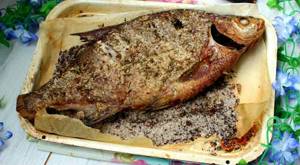
Bream soup
Ushitsa cooked over a fire is a nice thing for a fisherman. But you can also make a wonderful rich soup at home if you follow the recipe.
Ingredients:
- Bream.
- Potatoes – 4-6 tubers.
- Bulb.
- Carrot.
- Salt, pepper, oil for frying.
How to cook:
- Clean the carcasses and remove the entrails. The head and fins do not need to be removed. Place small fish whole, cut large fish into pieces. Immediately add the whole onion and the carrots cut into slices.
- Pour in enough water and let it cook.
- When the fish is cooked, remove it and remove the bones.
- Instead of fish, add diced potatoes to the broth.
- Season with salt, pepper, and toss in the bay leaves. Cook until the potatoes are done.
- When serving, add dill.
How to properly gut a bream
You can gut bream correctly if you follow the instructions for cutting this fish step by step:
- Holding the fish head with your left hand, you should gradually remove the scales with your right hand using a knife or a special scraper, starting from the tail.
- On both sides, make cuts in the flesh around the fins and cut them off with scissors.
- Trim the flesh around the head to the spine and break it with your hands.
- In the direction from the tail to the head, rip open the belly with a knife or scissors and carefully remove the entrails.
- Next you need to remove the film from the inside of the spine and remove blood clots.
- Rinse the fish carcass thoroughly with cold water.
